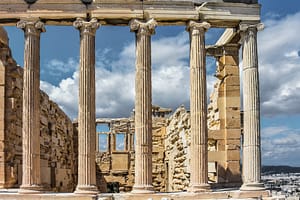MUSEUMS
National Archaeology Museum
Founded in the 19th century, Athens’ National Archaeological Museum is the largest archaeological museum in Greece and one of the greatest antiquities museums in the world. The museum is housed in an impressive Neoclassical building with 8,000 square meters of exhibition space. On display are five permanent collections with more than 11,000 exhibits, offering a comprehensive overview of Greek civilization from prehistory through the classical period to late antiquity. The Prehistoric Collection covers the sixth millennium BC to 1050 BC (the Neolithic, Cycladic, and Mycenaean periods) and presents findings from the prehistoric settlement at Thera. The Sculpture Collection exhibits ancient Greek sculptures from the sixth century BC to the fifth century BC, including rare masterpieces. The Vase and Decorative Objects Collection showcases ancient Greek pottery from the 11th century BC all the way until the classical Roman period. The Stathatos Collection features minor objects from a wide range of historical periods. Exquisite little statues and figurines sculpted from metals are on display in the Metallurgy Collection.
Byzantine Museum
This interesting museum offers fascinating insights into the Byzantine period of Greek history. Housed in a 19th-century palace originally built for the Duchesse de Plaisance, the wife of Charles-François Lebrun of France, the museum displays a precious collection of Byzantine art. The Byzantine Empire was the inheritance of the eastern half of the Roman Empire after it fell; the expansive empire was officially Orthodox Christian in religion and Greek speaking. From the third century to the 15th century, the Byzantine Empire ruled over the land of what is now the Balkans, Greece, and Asia Minor. During this time, religious art was highly valued. Byzantine artists created masterpieces of detailed, glittering mosaics and gilded icons. With more than 25,000 artifacts on display, the Byzantine Museum is a treasury of religious artifacts from the Byzantine period as well as pieces from the early Christian, medieval, and post-Byzantine eras. The collection includes sculptures, paintings, icons, textiles, and mosaics. Highlights are the architectural fragments from early Christian basilicas and Byzantine churches and the reproduction of a fountain depicted at the Monastery of Dafní. The museum’s courtyard features a splendid fragment of a mosaic floor from the fifth century.
National Archaeology Museum
Founded in the 19th century, Athens’ National Archaeological Museum is the largest archaeological museum in Greece and one of the greatest antiquities museums in the world. The museum is housed in an impressive Neoclassical building with 8,000 square meters of exhibition space. On display are five permanent collections with more than 11,000 exhibits, offering a comprehensive overview of Greek civilization from prehistory through the classical period to late antiquity. The Prehistoric Collection covers the sixth millennium BC to 1050 BC (the Neolithic, Cycladic, and Mycenaean periods) and presents findings from the prehistoric settlement at Thera. The Sculpture Collection exhibits ancient Greek sculptures from the sixth century BC to the fifth century BC, including rare masterpieces. The Vase and Decorative Objects Collection showcases ancient Greek pottery from the 11th century BC all the way until the classical Roman period. The Stathatos Collection features minor objects from a wide range of historical periods. Exquisite little statues and figurines sculpted from metals are on display in the Metallurgy Collection.
Byzantine Museum
This interesting museum offers fascinating insights into the Byzantine period of Greek history. Housed in a 19th-century palace originally built for the Duchesse de Plaisance, the wife of Charles-François Lebrun of France, the museum displays a precious collection of Byzantine art. The Byzantine Empire was the inheritance of the eastern half of the Roman Empire after it fell; the expansive empire was officially Orthodox Christian in religion and Greek speaking. From the third century to the 15th century, the Byzantine Empire ruled over the land of what is now the Balkans, Greece, and Asia Minor. During this time, religious art was highly valued. Byzantine artists created masterpieces of detailed, glittering mosaics and gilded icons. With more than 25,000 artifacts on display, the Byzantine Museum is a treasury of religious artifacts from the Byzantine period as well as pieces from the early Christian, medieval, and post-Byzantine eras. The collection includes sculptures, paintings, icons, textiles, and mosaics. Highlights are the architectural fragments from early Christian basilicas and Byzantine churches and the reproduction of a fountain depicted at the Monastery of Dafní. The museum’s courtyard features a splendid fragment of a mosaic floor from the fifth century.
Museum of Cycladic Art
In the Kolonáki quarter, the Museum of Cycladic Art was created in 1986 by the Nicholas and Dolly Goulandris Foundation. The shipowner Nikolas P. Goulandris was a well-known patron of the arts and cultural life in Athens. Goulandris’ own collection forms the core of the museum’s exhibits. Housed in a sleek modern building with a facade of marble and glass, the museum’s permanent collection includes more than 3,000 objects. The collection represents ancient Greek art, ancient art of the Cyclades (the islands in the Aegean Sea encircling the Island of Delos near Mykonos), and Cypriot art (from the island of Cyprus) dating from the fourth century BC to the sixth century AD. Many of the artifacts on display date to the sixth century BC. Temporary exhibits are held at the elegant 19th-century Stathatos Mansion, accessible from the main building by a passageway from the atrium.

